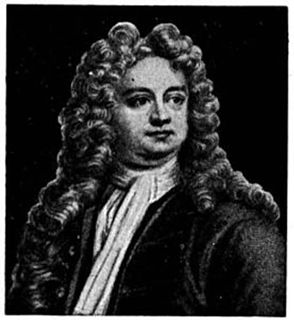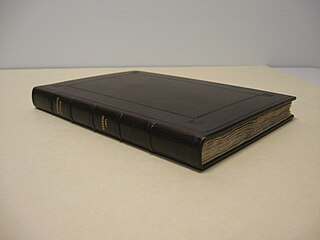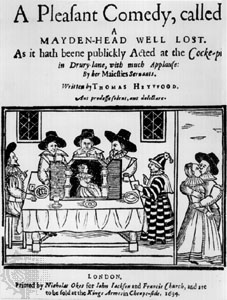The Master of the Revels was the holder of a position within the English, and later the British, royal household, heading the "Revels Office" or "Office of the Revels". The Master of the Revels was an executive officer under the Lord Chamberlain. Originally he was responsible for overseeing royal festivities, known as revels, and he later also became responsible for stage censorship, until this function was transferred to the Lord Chamberlain in 1624. However, Henry Herbert, the deputy Master of the Revels and later the Master, continued to perform the function on behalf of the Lord Chamberlain until the English Civil War in 1642, when stage plays were prohibited. The office continued almost until the end of the 18th century, although with rather reduced status.
This article is a summary of the literary events and publications of 1631.
John Webster was an English Jacobean dramatist best known for his tragedies The White Devil and The Duchess of Malfi, which are often regarded as masterpieces of the early 17th-century English stage. His life and career overlapped William Shakespeare's.

John Ford was an English playwright and poet of the Jacobean and Caroline eras born in Ilsington in Devon, England.
John Day (1574–1638?) was an English dramatist of the Elizabethan and Jacobean periods.

The Shakespeare apocrypha is a group of plays and poems that have sometimes been attributed to William Shakespeare, but whose attribution is questionable for various reasons. The issue is separate from the debate on Shakespearean authorship, which addresses the authorship of the works traditionally attributed to Shakespeare.
City comedy, also known as citizen comedy, is a genre of comedy in the English early modern theatre.

George Lillo was an English playwright and tragedian. He was also a jeweller in London. He produced his first stage work, Silvia, or The Country Burial, in 1730, and a year later his most famous play, The London Merchant. He wrote at least six more plays before his death in 1739, including The Christian Hero (1735), Fatal Curiosity (1737) and Marina (1738).
Thomas of Woodstock and Richard the Second Part One are two names for an untitled, anonymous and apparently incomplete manuscript of an Elizabethan play depicting events in the reign of King Richard II. Attributions of the play to William Shakespeare have been nearly universally rejected, and it does not appear in major editions of the Shakespeare apocrypha. The play has been often cited as a possible influence on Shakespeare's Richard II, as well as Henry IV, Parts 1 and 2, but new dating of the text brings that relationship into question.
The Children of the Chapel were the boys with unbroken voices, choristers, who formed part of the Chapel Royal, the body of singers and priests serving the spiritual needs of their sovereign wherever they were called upon to do so. They were overseen by the Master of the Children of the Chapel Royal.
Perkin Warbeck is a Caroline era history play by John Ford. It is generally ranked as one of Ford's three masterpieces, along with 'Tis Pity She's a Whore and The Broken Heart. T. S. Eliot went so far as to call Perkin Warbeck "unquestionably Ford's highest achievement...one of the very best historical plays outside of the works of Shakespeare in the whole of Elizabethan and Jacobean drama."
A Woman Killed with Kindness is an early seventeenth-century stage play, a tragedy written by Thomas Heywood. Acted in 1603 and first published in 1607, the play has generally been considered Heywood's masterpiece, and has received the most critical attention among Heywood's works. Along with the anonymous Arden of Faversham, Heywood's play has been regarded as the apex of Renaissance drama's achievement in the subgenre of bourgeois or domestic tragedy.
George Eld was a London printer of the Jacobean era, who produced important works of English Renaissance drama and literature, including key texts by William Shakespeare, Ben Jonson, Christopher Marlowe, and Thomas Middleton.

The term memorial reconstruction refers to the hypothesis that the scripts of some 17th century plays were written down from memory by actors who had played parts in them, and that those transcriptions were published. The theory is suggested as an explanation for the so-called "bad quarto" versions of plays, in which the texts differ dramatically from later published versions, or appear to be corrupted or confused.
The Lady Mother is a Caroline era stage play, a tragicomedy generally attributed to Henry Glapthorne, and dating from the middle 1630s. Never printed in its own era, the play survived in a manuscript marked as a theatre prompt-book, revealing significant details about the stage practice of its time.

Shakespeare attribution studies is the scholarly attempt to determine the authorial boundaries of the William Shakespeare canon, the extent of his possible collaborative works, and the identity of his collaborators. The studies, which began in the late 17th century, are based on the axiom that every writer has a unique, measurable style that can be discriminated from that of other writers using techniques of textual criticism originally developed for biblical and classical studies. The studies include the assessment of different types of evidence, generally classified as internal, external, and stylistic, of which all are further categorised as traditional and non-traditional.

Drexel 4041 is a 17th-century British music manuscript commonplace book. As described by musicologist John P. Cutts, Drexel 4041 "is a treasure-house of early seventeenth-century song and dramatic lyric worthy of the attention of any student of seventeenth-century literature and drama." It is also a major source for the work of English composer William Lawes. Belonging to the New York Public Library, it forms part of the Drexel Collection, housed in the Music Division of the New York Public Library for the Performing Arts. Following traditional library practice, its name is derived from its call number.
The Woeful Lamentation of Jane Shore is an English broadside ballad from the 17th century. It tells the story of Jane Shore, a mistress of King Edward IV, and her downfall after the death of Edward. Copies of the broadside can be found at the British Library, the University of Glasgow Library, and Magdelene College.








